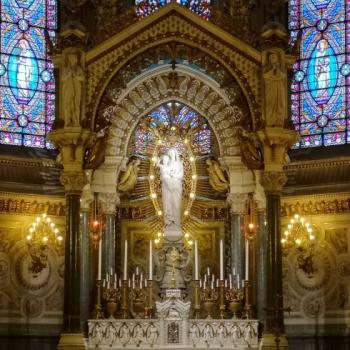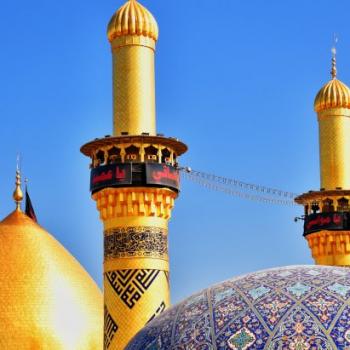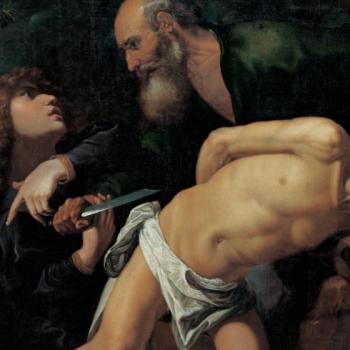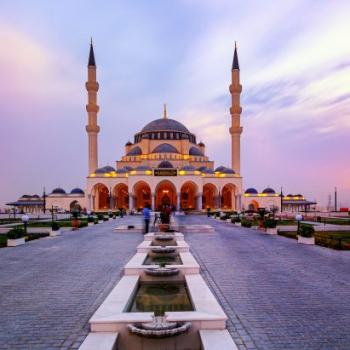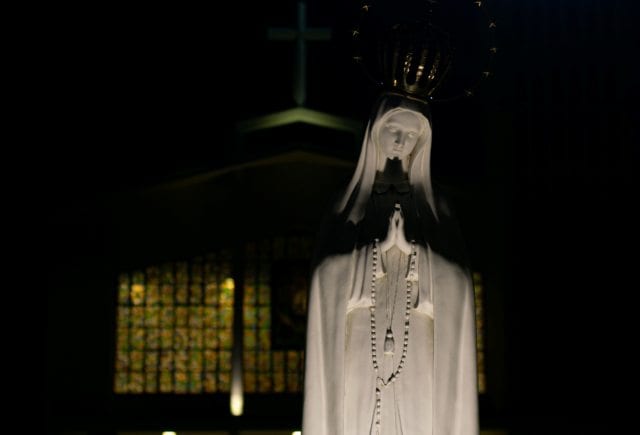
In the month of May, Catholics focus particular attention on the role of the Blessed Virgin Mary in the life of faith. On May 13th, the feast of Our Lady of Fatima is observed, commemorating the first apparition to three shepherd children in a small town of Fatima in Portugal. Her core message was to call for people to repent from sin and turn back to God, as well as urge the faithful to prayer for the conversion of sinners everywhere and a lasting world peace. Famously, at the conclusion of the final apparition, a crowd of thousands saw the “miracle of the sun”, in which the great orb in the sky seemed to spin from its axis before returning to its place in the heavens.
As has been brought up elsewhere, there is an interesting tie-in between the name of this town and the name of Fatima, the daughter of Muhammad. Legend has it town itself was named for after Arab woman who converted from Islam to Christianity, married a Portuguese man, and settled down in the region. When she died, he named the area in her memory. Given the multi-layered cultural history of the Iberian Peninsula, with various cases of conversion and intermarriage as control shifted back and forth between Christians and Muslims, this is easy to believe.
But the main connection that jumps to mind for me is just the way in which both Mary, the Mother of Jesus, and Fatima, the Daughter of Muhammad, are seen as these feminine vessels of grace and piety by their respective traditions, and how both are visited by angels and serve as conduits of wholeness and holiness for others. In this they share a common archetypal place in the spiritual imagination, distinct from the goddess traditions within paganism in that they claim no divinity for themselves, but rather reflect an intimate union with the Creator as His creations.
There are countless stories about both offering what they have to others. In the Gospel of John, Mary famously urges Jesus to perform the miracle of the Wedding Feast, turning water into wine, urging the servers to do whatever He tells them, so that the young couple would not be embarrassed. She also stands at the foot of the cross, bearing the full brunt of her Son’s agony. She becomes the mother of the “Beloved Disciples”, who takes her into his home upon Christ’s final instruction from the cross. As such she surrogates not only St. John, but also the whole Church.
In the Gospel of Luke, she rushes off to visit her pregnant cousin Elizabeth, and aids her through her pregnancy. She keeps secrets deep in her heart, when shepherds, kings, and prophets tell her mysteries of her son’s destiny. In Coptic tradition, she bathes her child first in a spring so that a sickly child may bathe afterwards and be cured, and the cave where she nurses becomes a source of renewed milk for the breasts of dry mothers who make pilgrimage there. In Islamic tradition she receives fruit from the angels in her cell, in preparation for the fruit of her womb, announced by another angelic visitation.
Fatima, too, is knit into the angelic sphere, seeming half in the world and half beyond it. Her father’s mission to proclaim the oneness of God to a polytheistic society costs his family’s honor and security. She has to clean off the camel dung thrown at him, and suffer through her mother Khadijah’s death, after they are driven outside Mecca. Later, after the early Muslim community settles down, she gives her clothes to the poor, and the angels show themselves adorned in them. She offers food to any who supplicate, even if it means going hungry herself.
One story tells how she suffers illness, and sends her husband Ali out to find her a pomegranate to ease her fever, even though they are out of season. When he finally finds one, he winds up splitting it between two sick beggars he meets on the way home. But when he returns to his house, feeling guilty for failing his wife, he finds her sitting with a basket of pomegranates outside the door. Evidently the angels set about another task to show favor to those who cooperate with the graces bestowed on them by their Lord.
Later, in the legends out of Shia tradition told of the Battle of Karbala, and her son Hussain’s demise battling against the tyrant Yazid, she becomes a figure not unlike Christian depictions of the sorrowful Mother Mary, lamenting the slaughter of innocent her son by sinful men. And yet, in the grief is off-set by a sense of bearing witness to something beyond tragedy, something which sows the seeds of hope and consolation, of the eternal justice of God, which weeps along with them. Yet goodness and truth cannot be slain, and redemption may be found through the sting of suffering. Any death may yet open the gate to some new life.
Both Mary and Fatima are seen, in their respective traditions, as “queens of paradise.” And what is a queen of paradise? Perhaps it has less to do with crowns and scepters, and more to do with a certain fullness of being, a height of proximity to the divine light that it shines through, like the sun through a prism, or plays like wind through a reed. It is as Mary in the Magnificat says, that God “casts down the mighty from their thrones…and raises up the humble.” Perhaps it is in putting our foreheads to the ground that we are lifted up to the place where the sun dances.
Within Christian belief, this reality instilled within and embraced by the Virgin Mary enables her to receive the Incarnate Word within her womb, and as such she becomes the gateway of the mystery of the Incarnation, of God revealing Himself to Man, through the Person of Jesus Christ, fully God and fully. She becomes a guidepost on the journey of the Christian life, traversing the “one-ing” of God and Man through the life, death, and resurrection of her Son. In the same way, she stands in the liminal places between our passing from one world into another, and we invoke her to “pray for us now and at the hour of our death.”
But even within the Islamic tradition, there is an understanding of the extent of her purity to receive the miracle of conception without a man, bringing forth the Prophet Issa, whose mission to teach and heal she seems to embody within her very self. She must carry this force within her very body, like a seed ready to burst open and bear new fruit. The image of the date tree lowering its branches to feed her while she is in labor mirrors this notion of the fruitfulness of the divine life which she partakes in to a unique extent. Indeed, in Sufi thought, there has been a tradition of seeing the dome of mosques as a reflection of the fullness of Maryam’s womb.
So what do we take away from all this? Perhaps to appreciate the unique way in which God manifests His power and grace through the feminine genius. Perhaps we see it reflected in the wholeness of self-giving love, offering body and soul completely to the service of the divine will, and such becoming a way in which we should pour ourselves out for others, just as God fills us with presence. Indeed, Mary and Fatima both uniquely capture a quality that make them oracles of the sacred feminine. It is also why a talisman popular in parts of the Middle East and North Africa is alternately referred to as “Fatima’s Hand” or “Maryam’s Hand”, to drive evil away.
I think of these two women, so iconic to so many of us, and the way in which there names overlap today, and I imagine both of them with their hair covered in reverence and modesty, as true Middle Eastern Monotheistic women. But most importantly, I see them as being covered in “noor”, in that angelic light that bears fruit in ways that are always surprising, and ever ripe. Perhaps it is this spiritual “ripeness” which makes spring such a beautiful time to call to make this particular quality, when newness and wonder enlighten our world. In this they transcend any time, location, or ethnicity, but reflect a ray of the human experience which ever seeks after, and has been sought after, by the divine.



